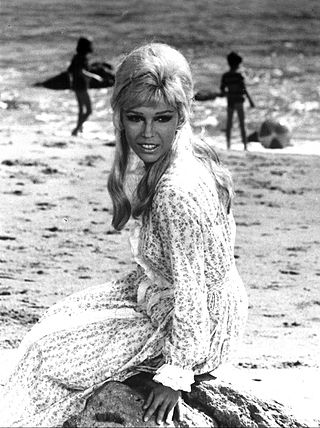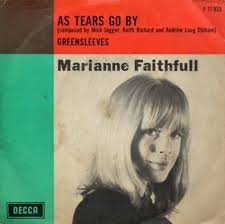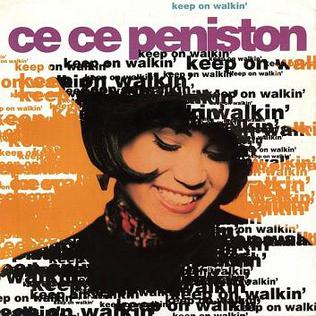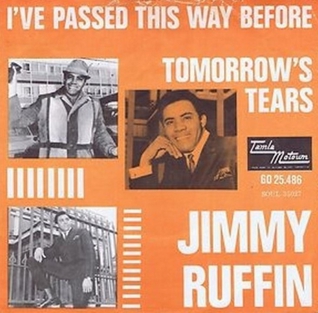Related Research Articles

Nancy Sandra Sinatra is an American singer-songwriter, actress, film producer and author. She is the elder daughter of Frank Sinatra and Nancy Sinatra and is known for her 1965 signature hit "These Boots Are Made for Walkin'".

The Supremes A' Go-Go is the ninth studio album released by Motown singing group the Supremes. It was the first album by an all-female group to reach number-one on the Billboard 200 album charts in the United States.

"These Boots Are Made for Walkin'" is a hit song written by Lee Hazlewood and recorded by American singer Nancy Sinatra. It charted on January 22, 1966, and reached No. 1 in the United States Billboard Hot 100 and in the UK Singles Chart.

"Strangers in the Night" is a song composed by Bert Kaempfert with English lyrics by Charles Singleton and Eddie Snyder. Kaempfert originally used it under the title "Beddy Bye" as part of the instrumental score for the movie A Man Could Get Killed. The song was made famous in 1966 by Frank Sinatra.

"Diamonds and Pearls" is the title track of American musician Prince and The New Power Generation's 1991 album and was released as a single in November 1991. The song is an upbeat ballad, given a rock edge with guitar and heavy drumming. It also features the vocals of NPG member Rosie Gaines. The ballad is an expression of love and not lust, as is the theme on some of the other singles from the album. It was a top 10 hit, reaching number three in the US and the top spot on the R&B chart. The pearls in the accompanying music video come from Connie Parente, a Los Angeles jewelry collector and designer.

"This Is How We Do It" is the debut single of American singer-songwriter Montell Jordan. It was released by Def Jam Recordings on February 6, 1995, as the lead single from his debut studio album of the same name (1995). The single was Def Jam's first R&B release, and is Jordan's signature song.

"As Tears Go By" is a song written by Mick Jagger, Keith Richards and Rolling Stones' manager Andrew Loog Oldham. Marianne Faithfull recorded and released it as a single in the United Kingdom in 1964. Her song peaked at number nine on both the UK and Irish singles charts. Later, the Rolling Stones recorded their own version, which was included on the American album December's Children . London Records released it as a single, which reached number six in the Billboard Hot 100 singles chart.
"A Groovy Kind of Love" is a song written by Toni Wine and Carole Bayer Sager based on a melody by the classical composer Muzio Clementi.

"Bang Bang (My Baby Shot Me Down)" is the second single by American singer-actress Cher from her second album, The Sonny Side of Chér (1966). It was written by her husband Sonny Bono and released in 1966. It reached No. 3 in the UK Singles Chart and No. 2 on the Billboard Hot 100 for a week (behind "(You're My) Soul and Inspiration" by The Righteous Brothers), eventually becoming one of Cher's biggest-selling singles of the 1960s.

"Walkin' on the Sun" is a song by American rock band Smash Mouth from their first album, Fush Yu Mang (1997). Smash Mouth released it as their debut single in June 1997, the song was Smash Mouth's first major single, reaching No. 1 on the US Billboard Modern Rock Tracks chart and No. 2 on the Billboard Hot 100 Airplay chart. It was also a success abroad, peaking at No. 3 in Canada and Iceland, No. 5 in Italy and Spain, and No. 7 in Australia, where it is certified platinum for shipments exceeding 70,000 units.

"19th Nervous Breakdown" is a song recorded by the English rock band the Rolling Stones. Written by Mick Jagger and Keith Richards, it was recorded in late 1965 and released as a single in February 1966. It reached number 2 on both the US Billboard Hot 100 and Britain's Record Retailer chart, while topping the charts compiled by Cash Box and NME.

"Love Is Like an Itching in My Heart" is a 1966 song recorded by the Supremes for the Motown label.
"Winchester Cathedral" is a song by the New Vaudeville Band, a British novelty group established by the song's composer, Geoff Stephens, and was released in late 1966 by Fontana Records.

"With a Girl Like You" is a song by English rock band the Troggs, released as a single in July 1966. On the back of the success of "Wild Thing", "With a Girl Like You" topped the charts in the UK, and was similarly a success across Europe, but did not fare as well in the US, only peaking at number 29 on the Billboard Hot 100.

How Does That Grab You? is the second studio album by Nancy Sinatra, released on Reprise Records in 1966. Arranged and conducted by Billy Strange, the album was produced by Lee Hazlewood. It peaked at number 41 on the Billboard 200 chart. The single, "How Does That Grab You, Darlin'?", reached number 7 on the Billboard Hot 100 chart, as well as number 19 on the UK Singles Chart.

You Ain't Woman Enough is the seventh solo studio album by American country music singer-songwriter Loretta Lynn. It was released on September 12, 1966, by Decca Records. It was Lynn's first No. 1 album on the US Billboard Hot Country Albums chart, as well as her first album to chart on the Billboard Top LPs chart.

"Puss N' Boots/These Boots " is a song by Canadian duo Kon Kan, released as the third single from their 1989 debut album Move to Move. The song peaked at No. 61 in their native Canada, and at No. 58 on the U.S. Billboard Hot 100. In October 1989, the song peaked at No. 11 in New Zealand.

"Keep On Walkin'" is a song by American musician CeCe Peniston, recorded for her debut album, Finally (1992), on A&M Records. Written by Steve Hurley, Marc Williams and Kym Sims, it was released in May 1992 as the singer's third single from the album and was her third number one on the US Billboard Hot Dance Music/Club Play chart. The single additionally peaked at number three on the US R&B chart, number 15 on the Hot 100, and number 10 in the United Kingdom.

"I've Passed This Way Before" is a song by American soul singer Jimmy Ruffin, released as a single in November 1966 from his album Jimmy Ruffin Sings Top Ten. It peaked at number 17 on the Billboard Hot 100 and number 29 on the UK Singles Chart.
References
- ↑ "April 15, 1966 - New Musical Express (Page 4)" (PDF). NME .
- ↑ "April 16, 1966 - Record Mirror (Page 9)" (PDF). Record Mirror .
- ↑ "April 16, 1966 - Melody Maker (Page 11)" (PDF). Melody Maker .
- ↑ "April 16, 1966 - Cashbox (Page 12)" (PDF). Cashbox .
- ↑ "Hot 100 - June 11, 1968". Billboard .
- ↑ "How Does That Grab You Darlin' | Full Official Chart History". Official Charts Company .
- ↑ "Search results for "Nancy Sinatra"". RPM .
- ↑ "AUT singles". austriancharts.at.